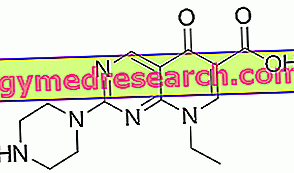EBV virus
Epstein-Barr Virus (EBV or HHV-4 or Herpes human virus 4) is a DNA virus belonging to the Herpesvirus family, the same as varicella, S. Antonio fire and labial / genital herpes.
Infections carried by Epstein-Barr Virus are extremely common: just think that 90-95% of the world population has come into contact with EBV at least once in their life.
Most individuals, despite being infected by the Epstein-Barr virus, get adaptive immunity: in other words, after contracting the infection, the body develops specific antibodies against the Epstein-Barr virus, without ever accusing any symptom of infection.
Related infections
The most common clinical manifestation associated with Epstein-Barr Virus is acute infectious mononucleosis, a self-limiting syndrome typical of adolescents and young adults. However, it should not be forgotten that the Epstein-Barr virus is also involved in the genesis of more serious, potentially deadly diseases. In fact, it appears that recurrent EBV infections are also related to the appearance of some tumor diseases, including:
- Hodgkin's lymphoma
- Burkitt lymphoma
- nasopharyngeal carcinoma
- central nervous system lymphomas associated with HIV infections
Furthermore, the Epstein-Barr virus would be somehow involved in the genesis of multiple sclerosis.
In this article we will try to shed light on a frequent question: how can the same virus transmit benign infections, of simple resolution (mononucleosis), and at the same time play a decisive role in the genesis of lymphomas or tumors? To answer the question, it is necessary to take a step back and study the mode of transmission, and the different life / replication cycles of the Epstein-Barr Virus.
Just as the papilloma virus is associated with cervical cancer, and the hepatitis B virus with hepatic carcinoma, the Epstein-Barr virus is also closely related to some cancers.
Virus transmission
Man is the exclusive host of Epstein-Barr Virus, although some species of anthropomorphic monkeys constitute a further, possible, reservoir.

Epstein-Barr Virus can also be transmitted via blood and sexual contact; however, these transmission modes are extremely rare.
After the initial inoculation in the target cells of the host, the virus replicates in the nasopharyngeal epithelial cells. Then, spreading to the different sites of the organism, the Epstein-Barr virus arrives first in the salivary glands and in the lymph nodes of the oropharyngeal tissues, then in the lymphoreticular system (B lymphocytes of the peripheral blood), thus reaching the spleen and the liver.
Two strains of Epstein-Barr Virus, EBV-1 and EBV-2 (also known as EBV type A and B ) have been identified; despite the genes expressed by the two strains during latent infection (analyzed below) show some slight differences, the acute affections they convey are apparently identical. The two Epstein-Barr virus strains have been detected all over the world, and can simultaneously infect the same person.
Lytic cycle and latent cycle
The Epstein-Barr virus has a spherical shape and is made up of a double lipoproteic membrane, the integument, which surrounds the icosahedral capsid (composed of capsomers: 150 exons and 12 pentons). The capsid preserves the genome inside (double-stranded DNA).
The target cells of Epstein-Barr Virus are human B lymphocytes: on the surface of the membrane, B lymphocytes have a receptor, to which some specific EBV virus glycoproteins are bound (gp325 and gp42).
The Epstein-Barr virus carries infections through two mechanisms:
- LITHIC CYCLE : the Epstein-Barr virus enters the host cell (B lymphocyte), inserts its own genome and produces numerous new virions (composed of nucleic acid + proteins). The host cell is therefore destined to lysis: after which, the virions are free and infect the neighboring cells, spreading like wildfire.
- LATENT OR LYSOGENIC CYCLE : in this case, the Epstein-Barr Virus injects its genome directly into the DNA of the host cell. The genetic heritage of the infected cell is called "provirus". When the host cell duplicates itself, the virus's DNA is also transmitted to the daughter cells. The Epstein-Barr virus remains in a LATENCY state, without producing viral cells (virions). This "latency" can last even a long time: what has been said explains why a person who came into contact with Epstein-Barr Virus can host a certain number of infected cells for life, without ever developing the symptoms of the infection.
After infecting the host, the virus can remain silent as long as the subject's immune defenses are lowered: in such conditions, favorable to its development, the virus shows the symptoms of the infection.

During the latent cycle, the Epstein-Barr virus produces some viral proteins called EBNA antigens (Epstein Barr Nuclear Antigens) . 6 different EBNA antigens have been identified, distinguished by numbers between 1 and 6. These viral proteins modulate the expression of some genes and activate B lymphocytes, inducing them to so-called "cellular immortalization" (an indefinite and uncontrolled proliferation).
Latency and tumors
The indiscriminate proliferation of B lymphocytes is influenced by three elements:
- EBNA viral antigens or proteins
- 3 membrane proteins: LMP1-2A-2B
- 2 non-polyadenylated RNA types: EBER1 and EBER2
Precisely on the basis of the combination of these three elements, it is possible to distinguish three different forms of latency, with the associated associated disease:
- Type I latency: appears to be associated with Burkitt lymphoma → EBNA-1 expression + Q promoter (Qp) + EBER 1 and 2 + LMP2A
- Type II latency: related to nasopharyngeal carcinoma → expression of the combination of EBNA-1 + promoter Q (Qp) + LMP1, LMP2A, EBERs
- Type III latency: similar to type I latency, this variant is also probably associated with Burkitt's lymphoma. Furthermore, it is found in some lymphomas (triggered by Epstein-Barr virus), in AIDS patients → EBNA 1-2-3-4-5-6 are transcribed by the promoter Wp / Cp. 9 latency proteins are transcribed.
In conclusion, 90-95% of the world population carries the Epstein-Barr virus: in many subjects, the virus does not generate any damage, in others it develops infectious mononucleosis and, in an even smaller number, the EBV contributes to genesis of some malignant tumors. We are therefore faced with a sort of "apparent paradox": the risk of developing cancer from an Epstein-Barr virus infection depends on the integrity of the host's immune system and on the expression of viral proteins. Clearly, AIDS patients, transplant recipients and all patients with severe immune system impairment are more susceptible to Epstein-Barr virus infections, therefore more at risk of developing cancer.



